Modernisation of Regional Roads Evaluated Using Ex-Post CBA
Abstract
1. Introduction
2. Materials and Methods
2.1. Identification of Reference Scenario and Impact Value Estimation
2.2. Inaccuracy Measurement
2.3. Set of Projects Evaluated
3. Results
3.1. Ex-Post Evaluation of Investment Costs
3.2. Ex-Post Evaluation of the Incidence of Traffic Accidents
3.3. Impact on NPV and Decision-Making about Project Implementation
4. Discussion
5. Conclusions
Author Contributions
Funding
Acknowledgments
Conflicts of Interest
Appendix A
| Project | Section Length (km) | NPV, Ex Ante (CZK Million) | NPV, Ex-Post (CZK Million) | MPE (NPV) | MAPE (NPV) |
|---|---|---|---|---|---|
| III/3657 Letovice, bridge 3657-3 | 0.01 | 0.0 | −1.9 | −5521.2% | 5521.2% |
| III/4135 Rybníky bridge 4135-3 | 0.01 | −11.7 | −12.9 | 10.6% | 10.6% |
| II/379 Lipůvka—Blansko, bridge 379-023 | 0.03 | −29.7 | −18.8 | −36.7% | 36.7% |
| III/3771 Předklášteří bridge 3771-3 | 0.03 | −42.3 | −42.5 | 0.4% | 0.4% |
| II/129 Humpolec—bridge 129-011 | 0.06 | 52.5 | 55.4 | 5.5% | 5.5% |
| III/4206 Pouzdřany, bridge 4206-2 | 0.07 | −43.5 | −10.8 | −75.1% | 75.1% |
| II/408 roundabout Kuchařovice II/399 | 0.10 | 2.2 | 9.8 | 355.8% | 355.8% |
| II/397 and III/3974, roundabout Čejkovice | 0.10 | 34.4 | 21.4 | −37.7% | 37.7% |
| II/130 Miletín—bridge 130-011 | 0.10 | 14.5 | 21.2 | 46.5% | 46.5% |
| III/13035 Hořice—bridge 13035-2 | 0.10 | −13.9 | −3.4 | −75.2% | 75.2% |
| II/398 Horní Dunajovice, bridge 398-009 | 0.12 | −7.9 | −9.8 | 24.7% | 24.7% |
| III/3993 Naloučany—bridge | 0.14 | −10.1 | −5.3 | −47.4% | 47.4% |
| III/15280 Modřice bridge | 0.18 | −74.5 | −34.7 | −53.4% | 53.4% |
| II/421 Zaječí bridge 421-010 | 0.25 | −47.8 | −40.1 | −16.2% | 16.2% |
| III/00221 Ladná, bridge 00221-2 | 0.26 | −16.1 | −13.3 | −17.5% | 17.5% |
| II/430 Vyškov through road, bridge 430-017 | 0.27 | −2.5 | −8.8 | 253.6% | 253.6% |
| II/391 Žďárec bridges 391-003, 391-004 | 0.28 | −8.9 | 2.2 | −124.8% | 124.8% |
| II/399 Stropešín—bridge 399-002 | 0.30 | −47.7 | −103.0 | 116.1% | 116.1% |
| II/380 Sokolnice roundabout | 0.33 | −9.8 | 4.5 | −145.9% | 145.9% |
| II/602 hr.kraje—Pelhřimov, 5. phase | 0.35 | −64.0 | −68.7 | 7.4% | 7.4% |
| II/409 Panské Dubenky—bridge 409-016 | 0.38 | 14.9 | 6.7 | −55.2% | 55.2% |
| II/602 Veselka roundabout | 0.40 | −18.5 | −19.0 | 3.1% | 3.1% |
| II/430 Podolí, roundabout | 0.47 | 35.2 | 44.3 | 26.0% | 26.0% |
| II/373 Ochoz through road 2. phase | 0.49 | 3.5 | 4.7 | 33.8% | 33.8% |
| III/03810 Hesov—bridges 03810-006, 007, 008 | 0.53 | 136.6 | 134.9 | −1.2% | 1.2% |
| II/374 Cetkovice through road | 0.55 | −5.0 | 4.4 | −187.6% | 187.6% |
| II/379 Lipůvka through road | 0.56 | −5.4 | 0.7 | −112.4% | 112.4% |
| II/408 Dyje through road | 0.57 | −8.1 | 7.8 | −196.4% | 196.4% |
| II/387 Bořínov—Nedvědice, border bridge 387-012 | 0.65 | −30.3 | −35.6 | 17.7% | 17.7% |
| II/399 Tavíkovice bridge 399-006 | 0.66 | −18.6 | −19.1 | 2.8% | 2.8% |
| II/400 Chlupice bridge 400-007 | 0.66 | −14.7 | −16.1 | 9.6% | 9.6% |
| Lužice through road IV. and V. phase | 0.77 | 30.3 | 12.7 | −58.1% | 58.1% |
| II/413 Prosiměřice bridge 413-014 | 0.80 | −19.5 | −0.6 | −97.2% | 97.2% |
| II/412 Znojmo, bridge 412-001, 412-002 | 0.85 | −55.2 | −43.7 | −20.9% | 20.9% |
| II/431 Vyškov—through road | 0.92 | 9.4 | 22.1 | 133.8% | 133.8% |
| II/422 Čejkovice through road III. phase | 0.94 | 4.3 | 3.5 | −18.7% | 18.7% |
| II/377 Brťov through road | 0.94 | −15.3 | −21.4 | 40.1% | 40.1% |
| II/602 Domašov bridge 602-013 | 0.97 | −33.4 | −20.6 | −38.2% | 38.2% |
| Connection I/38 Znojmo | 1.11 | 25.6 | 41.7 | 62.9% | 62.9% |
| III/37418 Boskovice, Chrudichromská | 1.12 | 1.4 | −11.4 | −909.5% | 909.5% |
| II/427 Moravský Písek II. and III. phase | 1.15 | −33.9 | −53.2 | 57.2% | 57.2% |
| III/4133 Moravský Krumlov through road | 1.17 | −22.2 | 35.5 | −260.3% | 260.3% |
| II/394 Neslovice through road | 1.19 | 27.7 | 12.9 | −53.5% | 53.5% |
| II/405 Zašovice—through road | 1.26 | 0.6 | −7.5 | −1355.1% | 1355.1% |
| II/394 Tetčice through road | 1.28 | 1.6 | 18.1 | 1059.7% | 1059.7% |
| II/422 Čejkovice—through road, phase 1 | 1.40 | 7.2 | 7.9 | 9.8% | 9.8% |
| Reconstruction of road III/4301 Bukovany—through road | 1.46 | 15.1 | 4.5 | −70.5% | 70.5% |
| II/398 Vranov nad Dyjí through road—Onšov | 1.55 | 81.0 | −42.2 | −152.1% | 152.1% |
| II/393 Oslavany—II. and IV. phase | 1.60 | 19.2 | 29.5 | 53.6% | 53.6% |
| II/416, 417 Křenovice through road | 1.61 | −18.6 | −39.4 | 111.5% | 111.5% |
| II/602 Ostrovačice 1. phase | 1.62 | 36.0 | −20.0 | −155.6% | 155.6% |
| II/381 Velké Němčice through road | 1.65 | 12.0 | 26.9 | 124.1% | 124.1% |
| II/432 Ratíškovice through road | 1.66 | 12.5 | 12.5 | 0.2% | 0.2% |
| II/421 Kobylí through road | 1.70 | 9.0 | 7.8 | −12.7% | 12.7% |
| II/408 Dyjákovice through road | 1.73 | −40.6 | −20.2 | −50.4% | 50.4% |
| III/01926, III/01928, III/01929 in Nová Cerekev | 1.75 | −46.3 | −45.9 | −0.9% | 0.9% |
| II/400 Hostěradice—Višňové, I. phase | 1.76 | 9.7 | −10.2 | −205.5% | 205.5% |
| II/360 Štěpánovice—Vacenovice | 1.78 | 6.4 | −10.6 | −266.1% | 266.1% |
| II/425 Nosislav through road | 1.78 | −6.9 | 13.9 | −301.0% | 301.0% |
| II/152 Jamolice—border of the region Vysočina | 1.79 | −3.8 | −7.7 | 102.7% | 102.7% |
| II/398 Mikulovice through road | 1.80 | −51.9 | −53.5 | 3.0% | 3.0% |
| II/150 Havlíčkův Brod—Okrouhlice | 1.81 | 7.2 | 22.5 | 213.5% | 213.5% |
| II/405 Zašovice—Okříšky | 1.85 | −124.9 | −138.0 | 10.5% | 10.5% |
| II/383 Pozořice—Sivice | 1.88 | −15.9 | −22.3 | 39.9% | 39.9% |
| II/360 ul. Rafaelova—Pocoucov | 1.88 | −60.3 | −62.4 | 3.5% | 3.5% |
| II/379 Tišnov—Lipůvka, section Nuzířov—Lipůvka | 1.90 | −0.6 | −34.4 | 5261.7% | 5261.7% |
| II/405 Příseka—Brtnice | 1.92 | −48.8 | −142.9 | 193.1% | 193.1% |
| II/385 Kuřim through road | 1.92 | 102.8 | 111.0 | 7.9% | 7.9% |
| II/152 Jamolice—Polánka up to crossroad III/15250 | 2.00 | −10.6 | −12.5 | 17.7% | 17.7% |
| II/353 D1—Rytířsko—Jamné, 2. phase | 2.02 | 22.7 | 11.2 | −50.5% | 50.5% |
| II/422 Svatobořice—Mistřín, phase 1 | 2.07 | 56.7 | 83.8 | 47.7% | 47.7% |
| II/602 Říčany-Říčky | 2.10 | 0.5 | 15.8 | 3231.4% | 3231.4% |
| II/432 Hodonín roundabout | 2.18 | 29.5 | 13.1 | −55.7% | 55.7% |
| III/42117 Bulhary through road | 2.19 | −6.8 | 35.4 | −620.9% | 620.9% |
| II/422 Svatobořice—Mistřín through road, II. phase | 2.20 | 3.0 | 42.6 | 1311.0% | 1311.0% |
| II/416 Pohořelice through road | 2.21 | 65.4 | 54.6 | −16.6% | 16.6% |
| III/4194 Vážany n/Litavou—Hrušky | 2.26 | −30.4 | −27.9 | −8.3% | 8.3% |
| II/345 Chotěboř—through road, 2. phase | 2.28 | 17.7 | −6.1 | −134.3% | 134.3% |
| II/374 Blansko through road | 2.30 | 283.6 | 303.2 | 6.9% | 6.9% |
| II/379 Lažánky through road | 2.41 | 80.7 | 70.9 | −12.1% | 12.1% |
| II/431, III/4301 Ždánice, Nechvalín through roads | 2.55 | −20.4 | 29.8 | −246.5% | 246.5% |
| II/380 Těšany through road | 2.87 | 14.8 | 80.7 | 444.7% | 444.7% |
| III/3773 Brumov—Bedřichov, bridge 3773-17 | 2.88 | −18.3 | −10.8 | −40.7% | 40.7% |
| III/40819 Hradiště through road | 2.89 | −15.2 | −46.6 | 206.0% | 206.0% |
| II/425 Hustopeče through road, roundabout | 3.00 | 142.3 | 135.1 | −5.1% | 5.1% |
| II/405 Příseka bypass | 3.09 | 60.4 | 63.4 | 4.9% | 4.9% |
| II/421 Bořetice through road—Kobylí | 3.34 | 1.6 | 27.0 | 1599.1% | 1599.1% |
| II/400 Přeskače—through road | 3.36 | −15.5 | 15.7 | −201.3% | 201.3% |
| II/152 Modřice bridges | 3.53 | 55.2 | 72.1 | 30.5% | 30.5% |
| II/395 Zastávka u Brna—border of the region, III. section | 3.58 | 4.8 | 15.1 | 212.6% | 212.6% |
| II/422 Čejč—Čejkovice | 3.67 | −18.4 | −72.3 | 293.9% | 293.9% |
| II/377 Rájec—Bořitov | 3.76 | −34.3 | −52.3 | 52.5% | 52.5% |
| II/347 Světlá n. S.—D1, 2. phase, section 1 | 3.76 | −69.2 | −54.9 | −20.7% | 20.7% |
| II/395 Odrovice through road | 3.84 | 9.0 | 3.7 | −58.5% | 58.5% |
| II/425, III/4217 Hustopeče—Horní Bojanovice | 3.96 | −16.7 | 80.2 | −579.3% | 579.3% |
| II/425 Hustopeče roundabout—Horní Bojanovice | 3.96 | 5.2 | 40.3 | 673.1% | 673.1% |
| II/602 border of the region—Pelhřimov, 4. phase, section 1 | 4.08 | −88.6 | −105.2 | 18.7% | 18.7% |
| II/602 border of the region—Pelhřimov, 7. phase, section 1 | 4.09 | 45.5 | −102.0 | −323.8% | 323.8% |
| II/385 Tišnov—Hradčany—Čebín | 4.10 | 165.1 | 182.0 | 10.2% | 10.2% |
| II/420 Hustopeče—Kurdějov | 4.15 | −18.2 | 10.9 | −160.0% | 160.0% |
| II/432 Ratíškovice—Hodonín, I/55 rural area | 4.28 | 31.6 | −15.6 | −149.5% | 149.5% |
| II/365 Letovice—Horní Poříčí, residential area | 4.45 | −10.1 | 14.5 | −242.8% | 242.8% |
| III/39613 crossroad Pasohlávky—Drnholec | 4.49 | −29.5 | −12.1 | −59.1% | 59.1% |
| II/402 Třešť—crossroad I/38 | 4.50 | 3.1 | −28.8 | −1019.0% | 1019.0% |
| III/4301 Ždánice—Bukovany, phase 1 | 4.77 | −35.7 | −25.6 | −28.3% | 28.3% |
| II/602 border of the region—Pelhřimov, 6. phase | 4.89 | −57.6 | −45.5 | −20.9% | 20.9% |
| II/347 Světlá n. S.—D1, 1. stavba | 5.00 | −145.2 | −203.2 | 39.9% | 39.9% |
| II/602 Popůvky—Ostrovačice | 5.03 | 64.1 | 84.5 | 31.9% | 31.9% |
| II/408 Suchohrdly u Znojma—Přímětice—I/38 (rural areas) | 5.07 | 21.4 | 20.3 | −5.3% | 5.3% |
| II/152 Ivančice—Polánka | 5.26 | 66.6 | 67.4 | 1.2% | 1.2% |
| II/398 Podmyče—Šafov | 5.36 | −21.6 | −29.2 | 35.5% | 35.5% |
| II/402 Batelov—Třešť | 5.50 | −9.8 | −33.9 | 245.7% | 245.7% |
| II/365 Horní Poříčí—Letovice, rural areas | 5.55 | 13.1 | −28.2 | −315.1% | 315.1% |
| II/430 Rousínov—Tučapy | 5.55 | 169.3 | 202.0 | 19.4% | 19.4% |
| II/373, III/37357 Benešov—Žďárná rural area | 5.69 | 7.3 | −33.0 | −552.4% | 552.4% |
| III/3783 Holštejn, bridge 3783-1 | 5.73 | −10.8 | 29.1 | −370.4% | 370.4% |
| II/408 Vranov nad Dyjí—Znojmo, rural area | 5.87 | 14.3 | −158.6 | −1211.5% | 1211.5% |
| II/425 Rajhrad—Židlochovice | 5.97 | 28.5 | 150.6 | 427.7% | 427.7% |
| II/374 Adamov—Bílovice nad Svitavou | 6.97 | −25.1 | −60.4 | 140.5% | 140.5% |
| II/413 Prosiměřice—Suchohrdly, extravilány | 7.23 | 17.0 | −49.9 | −393.4% | 393.4% |
| II/422 Čejkovice—Velké Bílovice | 7.35 | −42.8 | −45.9 | 7.3% | 7.3% |
| II/339 Ledeč nad Sázavou—border of the region | 7.61 | 12.7 | −13.4 | −205.3% | 205.3% |
| II/380 Těšany—Borkovany—Kašnice | 7.89 | 126.8 | 143.6 | 13.3% | 13.3% |
| II/602 hr. kraje—Pelhřimov, 3. phase | 7.91 | −66.3 | −143.0 | 115.6% | 115.6% |
| II/150 Boskovice—Valchov—Žďárná | 8.13 | 37.7 | −21.8 | −157.8% | 157.8% |
| II/424 Mor.Nová Ves—Tvrdonice—Lanžhot | 8.53 | 4.2 | 28.0 | 572.2% | 572.2% |
| II/523 Jihlava—Větrný Jeníkov | 9.19 | −32.5 | −238.0 | 632.7% | 632.7% |
| II/348, II/131 Štoky—Petrovice—Větrný Jeníkov | 9.40 | 231.0 | 11.8 | −94.9% | 94.9% |
| II/523 Větrný Jeníkov—Humpolec | 9.95 | −36.9 | 7.1 | −119.4% | 119.4% |
| II/398 Horní Dunajovice—Mikulovice—Pavlice rural zone | 10.66 | −53.6 | −82.0 | 52.8% | 52.8% |
| II/425 Nosislav—Velké Němčice—Starovičky | 10.73 | 210.7 | 169.3 | −19.6% | 19.6% |
| II/411 Moravské Budějovice—border of the region | 10.94 | −12.5 | −52.4 | 320.1% | 320.1% |
| III/03810 Havlíčkův Brod—Přibyslav | 11.36 | 23.4 | 28.5 | 21.6% | 21.6% |
| II/430 Vyškov through road | 11.41 | 333.4 | 276.3 | −17.1% | 17.1% |
| II/152 Jaroměřice—Hrotovice | 11.58 | −65.3 | −111.7 | 71.0% | 71.0% |
| II/410 from I/23—Želetava | 12.60 | −48.5 | −89.3 | 84.2% | 84.2% |
| II/639 Horní Cerekev—Kostelec | 12.95 | 81.1 | 50.3 | −38.1% | 38.1% |
| II/133 Horní Cerekev—crossroad II/602 | 14.59 | −67.3 | −85.8 | 27.5% | 27.5% |
| II/151, III/15113 from I/38—Budeč+Štěpkov-Budkov | 15.81 | −48.9 | −9.7 | −80.1% | 80.1% |
| II/379 Podomí—Drnovice | 16.16 | 73.7 | 61.9 | −16.0% | 16.0% |
| II/354 Nové Město na Moravě—Svratka | 16.51 | 29.6 | −26.2 | −188.7% | 188.7% |
| II/129 Cetoraz—Jiřičky | 19.71 | −77.1 | −143.7 | 86.3% | 86.3% |
| II/351 from II/602—Třebíč | 22.88 | 68.0 | −126.0 | −285.2% | 285.2% |
| II/360 Jimramov—Moravec | 23.76 | 24.3 | −2.8 | −111.7% | 111.7% |
| total | 564.62 | 1081.2 | −245.0 | 3.8% | 267.2% |
References
- Boardman, A.E.; Mallery, W.L.; Vining, A.R. Learning from ex ante/ex post cost-benefit comparisons: The Coquihalla highway example. Socio-Econ. Plan. Sci. 1994, 28, 69–84. [Google Scholar] [CrossRef]
- Odeck, J.; Kjerkreit, A. The accuracy of benefit-cost analyses (BCAs) in transportation: An ex-post evaluation of road projects. Transp. Rev. Part A Policy Pract. 2019, 120, 277–294. [Google Scholar] [CrossRef]
- European Commission. Transport/Task 3—Major Project Case Studies Work Package 5/Ex Post Evaluation of Cohesion Policy Programmes 2007–2013, Focusing on the European Regional Development Fund (ERDF) and the Cohesion Fund (CF). Available online: https://ec.europa.eu/regional_policy/sources/docgener/evaluation/pdf/expost2013/wp5_task3_en.pdf (accessed on 10 February 2020).
- eCBA s.r.o. Regional South-East Cohesion Government Office. System for Financial and Economic Evaluation of Regional Development Projects. 2008. Available online: https://cba.jihovychod.cz/ login.aspx?ReturnUrl=%2f (accessed on 1 December 2019).
- European Commission, Directorate-General for Regional and Urban Policy. Guide to Cost-Benefit Analysis of Investment Projects—Economic Appraisal Tool for Cohesion Policy 2014–2020. Available online: https://ec.europa.eu/regional_policy/sources/docgener/studies/pdf/cba_guide.pdf (accessed on 10 December 2019).
- Anguera, R. The Channel Tunnel—An ex post economic evaluation. Transp. Rev. Part A Policy Pract. 2006, 40, 291–315. [Google Scholar] [CrossRef]
- Börjesson, M.; Jonsson, R.; Lundberg, D. An ex-post CBA for the Stockholm Metro. Transp. Rev. Part A Policy Pract. 2014, 70. [Google Scholar] [CrossRef][Green Version]
- Jong, G.; Vignetti, S.; Pancotti, C. Ex-post evaluation of major infrastructure projects. Transp. Res. Procedia 2019, 42, 75–84. [Google Scholar] [CrossRef]
- Welde, M.; Volden, G. Measuring efficiency and effectiveness through ex-post evaluation: Case studies of Norwegian transport projects. Res. Transp. Bus. Manag. 2018. [Google Scholar] [CrossRef]
- Welde, M. In search of success: Ex-post evaluation of a Norwegian motorway project. Case Stud. Transp. Policy 2018, 6, 475–482. [Google Scholar] [CrossRef]
- Meunier, D.; Welde, M. Ex-post evaluations in Norway and France. Transp. Res. Procedia 2017, 26. [Google Scholar] [CrossRef]
- Nicolaisen, M.; Driscoll, P. An International Review of Ex-Post Project Evaluation Schemes in the Transport Sector. J. Environ. Assess. Policy Manag. 2016, 18. [Google Scholar] [CrossRef]
- Sudiana, I.P. How Effective is Cost-Benefit Analysis in Assisting Decision Making by Public Sector Managers? Case Studies of Two Australian Departments. 2010. Available online: http://www.crawford.anu.edu.au/degrees/pogo/discussion_papers/PDP10-01.pdf (accessed on 12 February 2020).
- Czech Republic Police, Centrum Dopravního Výzkumu V.V.I.; Czech Statistical Office. Statistical Evaluation of Accidents in the Map. Available online: http://maps.jdvm.cz/cdv2/apps/nehodyvmape/Search.aspx (accessed on 28 January 2020).
- Florio, M.; Vignetti, S. The Use of Ex Post Cost-Benefit Analysis to Assess the Long-Term Effects of Major Infrastructure Projects. SSRN Electron. J. 2013. [Google Scholar] [CrossRef]
- Lord, D.; Mannering, F. The statistical analysis of crash-frequency data: A review and assessment of methodological alternatives. Transp. Rev. Part A Policy Pract. 2010, 44, 291–305. [Google Scholar] [CrossRef]
- Czech Republic Police. Statistics of the Incidence of Traffic Accidents. 2019. Available online: https://www.policie.cz/clanek/statistika-nehodovosti-900835.aspx?q=Y2hudW09MTE%3d (accessed on 16 February 2020).
- Czech Statistical Office. Traffic Accidents and Their Consequences in the Czech Republic in the Long Term. 2014. Available online: https://www.czso.cz/documents/10180/20534694/32025414a.pdf/57d484eb-1939-47ad-8fef-f38d6dd2c19e?version=1.0 (accessed on 16 February 2020).
- Knudsen, D.C. Shift-Share Analysis: Further Examination of Models for the Description of Economic Change. Socio-Econ. Plan. Sci. 2000, 34, 177–198. [Google Scholar] [CrossRef]
- Střeleček, F.; Zdeněk, R.; Lososová, J. Shift-Share Analysis of Labour Productivity. In Inproforum 2009; University of South Bohemia in České Budějovice: České Budějovice, Czech Republic, 2009; ISBN1 978-80-7394-173-4. Available online: http://ocs.ef.jcu.cz/index.php/inproforum/INP2009/paper/viewFile/240/233 (accessed on 15 January 2020)ISBN2 978-80-7394-173-4.
- Ministerstvo dopravy ČR a SUDOP PRAHA a.s. Methodology for the Economic Effectiveness Evaluations of Transportation Projects. 2017. Available online: https://www.sfdi.cz/soubory/obrazky-clanky/metodiky/2017_02_rezortni_metodika-komplet.pdf (accessed on 20 November 2019).
- Centrum Dopravního Výzkumu, v.v.i. What Was the Total Cost of Traffic Accidents in 2015? 2016. Available online: https://www.czrso.cz/clanek/dopravni-nehody-nas-v-roce-2015-staly-68-miliard-zemrelo-737-osob/?id=1664 (accessed on 1 December 2019).
- Regional South-East Cohesion Government Office. Evaluation Tables ROP JV Support Area 1.1 Regional Infrastructure Development—Roads. 2010. Available online: http://www.jihovychod.cz/pro-prijemce/aktualni-vyzvy/dokumentace-k-vyzve-1-1/1-1-vyzva-k-20-12-2010 (accessed on 10 February 2020).
- European Commission. Directorate General Regional Policy. Guide to Cost-Benefit Analysis of Investment Projects. 2008. Available online: https://ec.europa.eu/regional_policy/sources/docgener/guides/ cost/guide2008_en.pdf (accessed on 26 February 2020).
- Regional South-East Cohesion Government Office. Form R17—Funding Draw-Down Projection; Regional South-East Cohesion Government Office: Brno, Czech Republic, 2019. [Google Scholar]
- Ambros, J. Jak měřit bezpečnost?—2. část [How to measure road traffic safety?—Part 2]. Road Superv. 2012, 73, 103–105. [Google Scholar]
- Odeck, J. Cost overruns in road construction—What are their sizes and determinants? Transp. Policy 2004, 11, 43–53. [Google Scholar] [CrossRef]
- Odeck, J. Do reforms reduce the magnitudes of cost overruns in road projects? Statistical evidence from Norway. Transp. Rev. Part A Policy Pract. 2014, 65. [Google Scholar] [CrossRef]
- Flyvbjerg, B.; Skamris Holm, M.K.; Buhl, S.L. What Causes Cost Overrun in Transport Infrastructure Projects? Transp. Rev. 2004, 24, 3–18. [Google Scholar] [CrossRef]
- Subramani, T.; Sruthi, P.S.; Kavitha, M. Causes of Cost Overrun In Construction. IOSR J. Eng. 2014, 4. [Google Scholar] [CrossRef]
- Czech Statistical Office. Míra růstu reálného HDP. 2020. Available online: http://apl.czso.cz/pll/eutab/html.h?ptabkod=tec00115 (accessed on 26 February 2020).
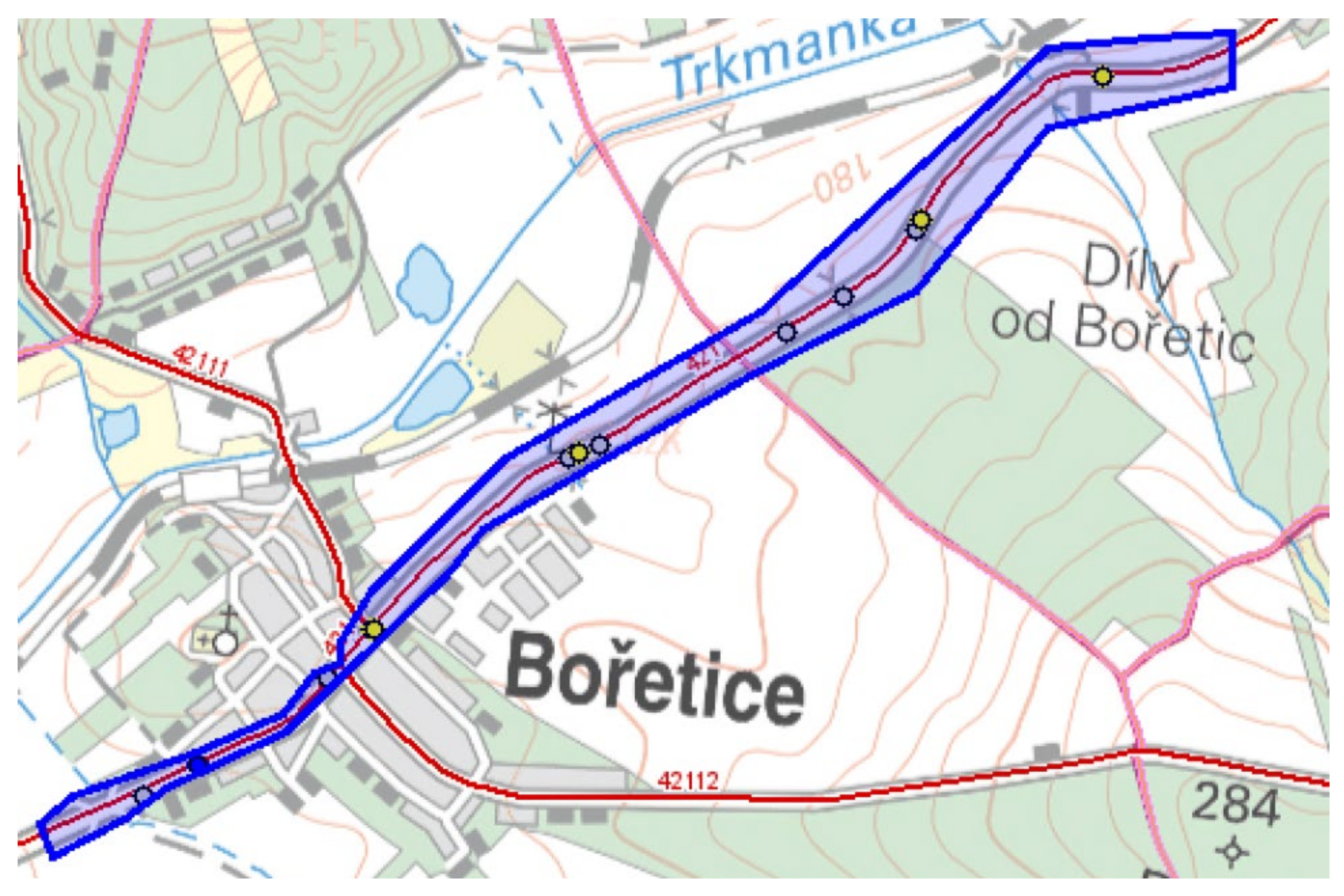


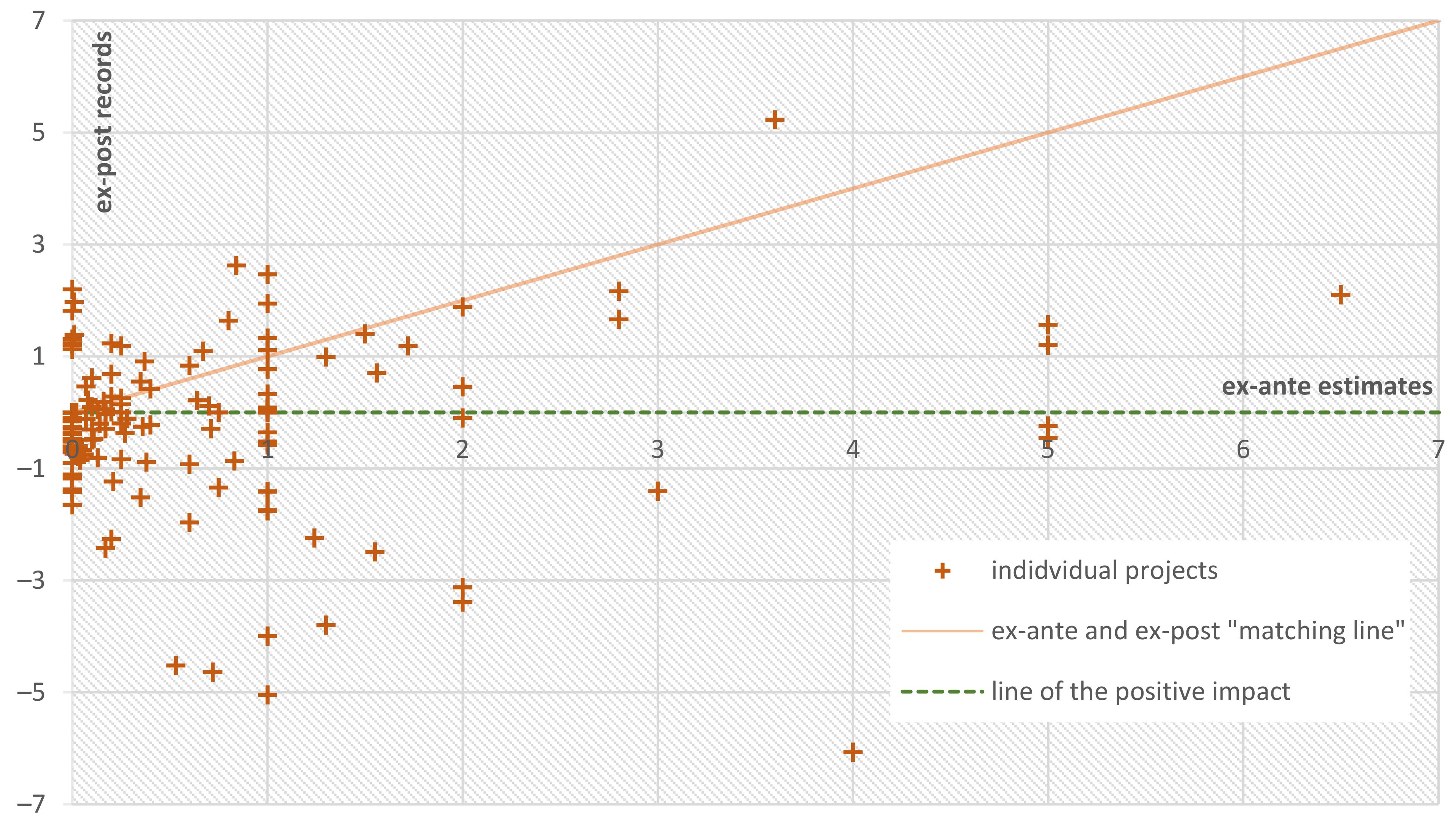
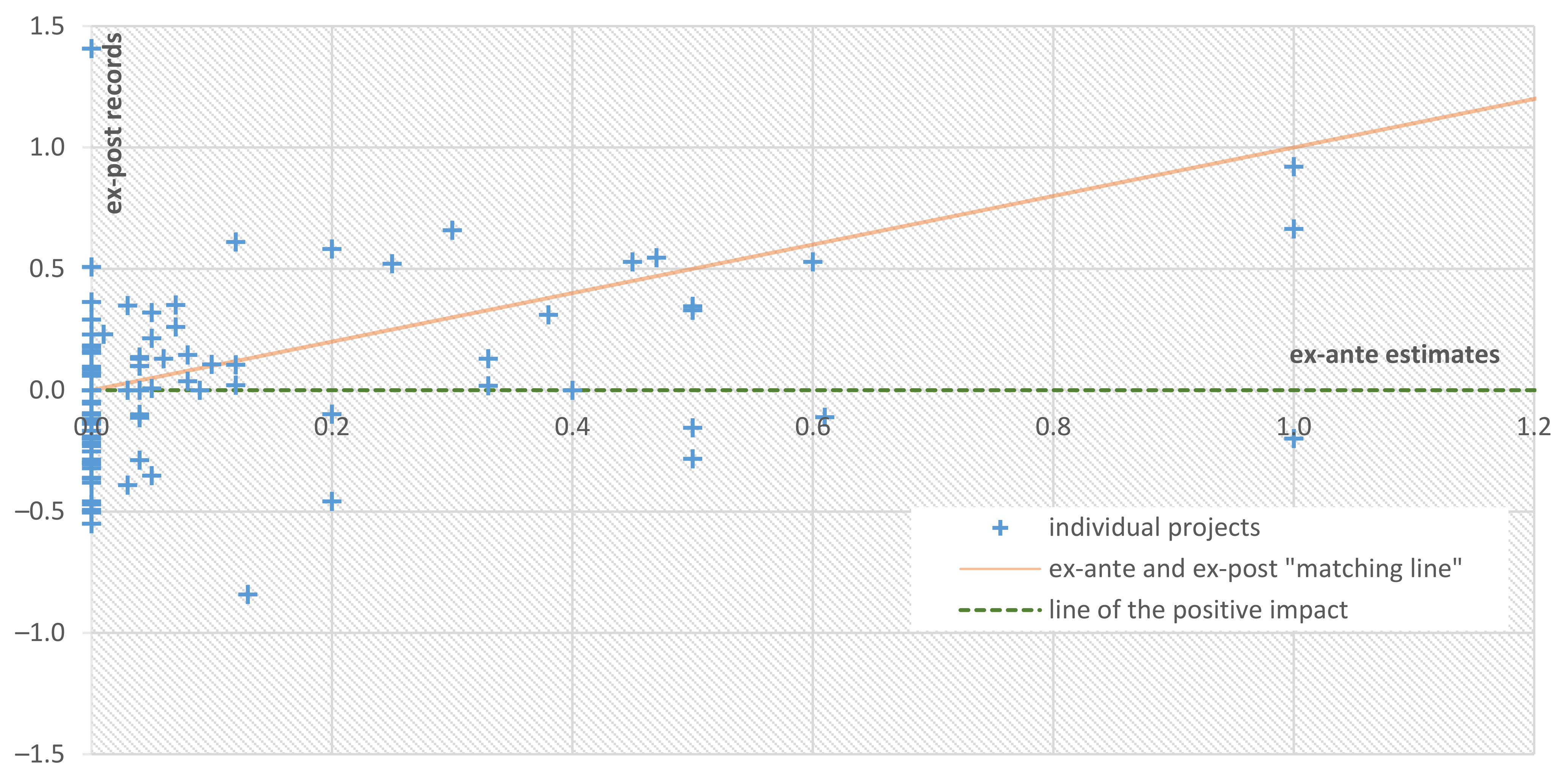
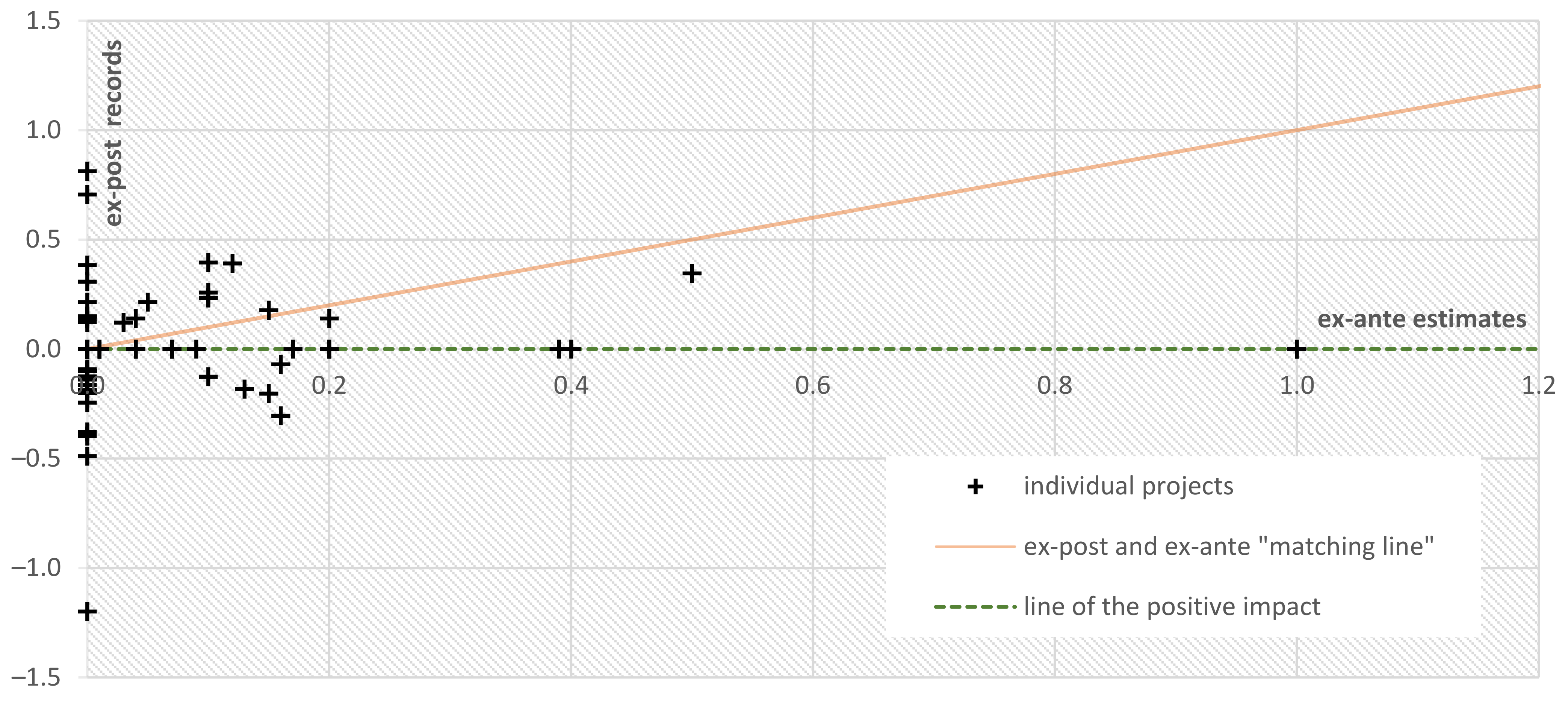
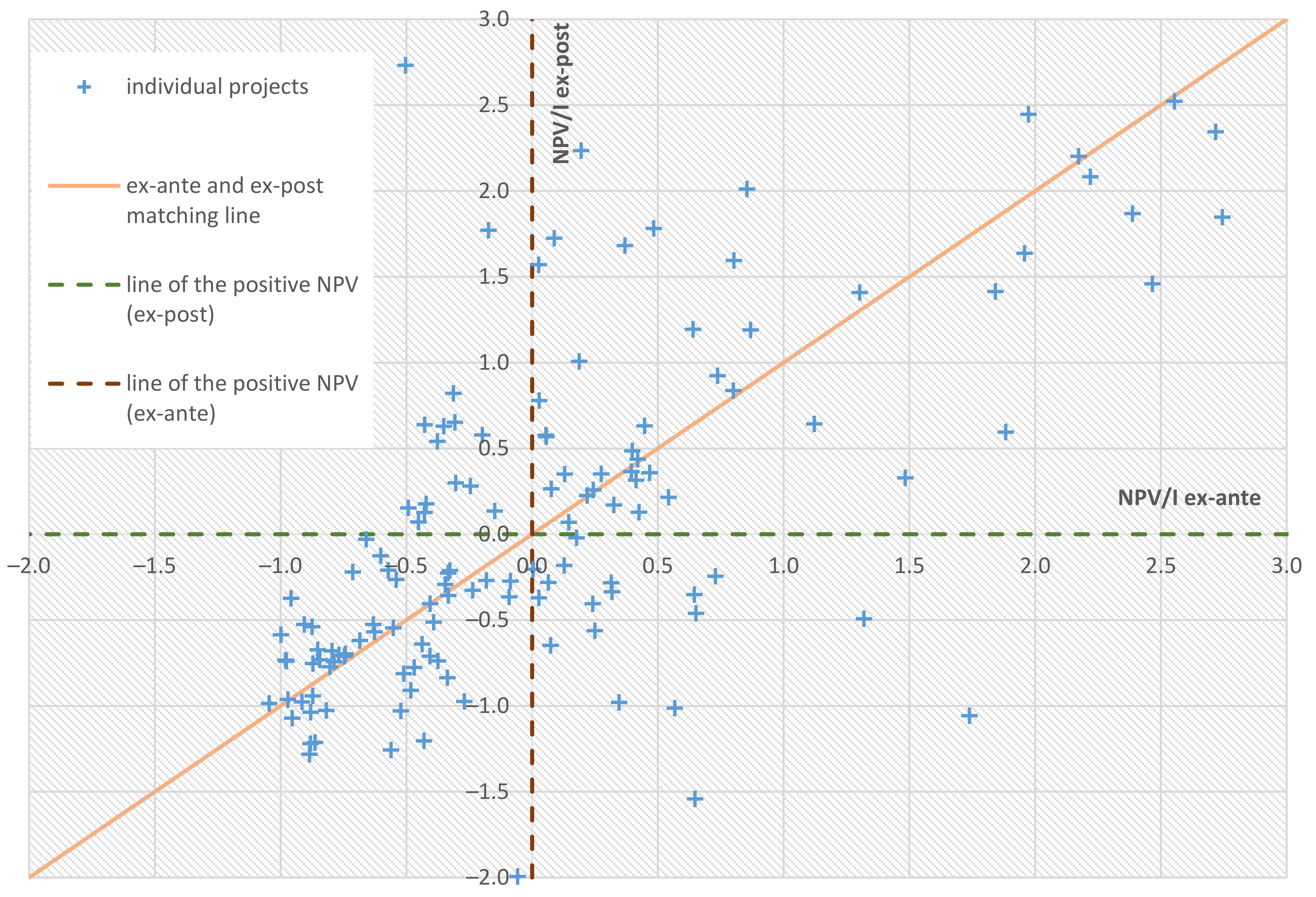

| Ex-Ante Method | Current Method | Current Method | |
|---|---|---|---|
| price level | 2008 | 2017 | 2008 |
| material damage | 48,500 | 344,900 | 282,973 |
| fatalities | 9,662,427 | 20,790,000 | 17,057,114 |
| serious injury | 3,243,737 | 5,033,600 | 4,129,807 |
| light injury | 364,577 | 649,800 | 533,127 |
| Ex-Ante | Ex-Post | MPE(I) | MAPE(I) | |
|---|---|---|---|---|
| average | 63.08 | 56.13 | −11.19% | 17.40% |
| median | 54.46 | 45.84 | −2.25% | 8.55% |
| min | 5.83 | 3.88 | −60.97% | 0.00% |
| max | 199.66 | 201.38 | 46.10% | 60.97% |
| reference deviation | 43.13 | 42.73 | 22.91% | 18.62% |
| projects in total | 144 | 144 | 144 | 144 |
| cost increase | 53 | |||
| cost decrease | 91 |
| Traced Prior to Project (Number) | Traced after Project Completion (Number) | Change (Number) | Change (%) | Ex-Ante Goal (Number) | Deviation (Number) | PE | |
|---|---|---|---|---|---|---|---|
| accidents total | 658.6 | 590.0 | −68.7 | −10.4% | 358.0 | −300.7 | 64.8% |
| light injuries | 235.3 | 277.1 | 41.8 | 17.8% | 135.1 | −100.2 | 105.2% |
| serious injuries | 30.7 | 30.6 | −0.1 | −0.4% | 15.7 | −15.0 | 94.6% |
| fatalities | 6.6 | 6.9 | 0.3 | 4.8% | 0.7 | −5.9 | 921.6% |
| Ex-Ante (Million CZK) | Ex-Post (Million CZK) | MPE(NPV) | MAPE(NPV) | |
|---|---|---|---|---|
| average | 7.51 | −1.70 | 3.8% | 267.2% |
| median | −0.30 | −5.67 | −3.1% | 58.8% |
| min | −145.17 | −237.97 | −5521.2% | 0.2% |
| max | 333.44 | 303.20 | 5261.7% | 5521.2% |
| reference deviation | 65.06 | 74.32 | 763.7% | 715.5% |
| number of projects | 144 | 144 | − | − |
| total | 1081.2 | −245.0 | − | − |
| Compliance with Criterion NPV > 0 | Number of Projects | Share (%) | Ex-Ante Points Average | Ex-Post Points Average |
|---|---|---|---|---|
| prior to = yes, after = yes | 52 | 36.1% | 6.6 | 8.8 |
| prior to = yes, after = no | 20 | 13.9% | 4.9 | 0.0 |
| prior to = no, after = yes | 15 | 10.4% | 0.0 | 5.7 |
| prior to = no, after = no | 57 | 39.6% | 0.5 | 0.0 |
| total | 144 | 100.0% | 3.3 | 3.8 |
Publisher’s Note: MDPI stays neutral with regard to jurisdictional claims in published maps and institutional affiliations. |
© 2021 by the authors. Licensee MDPI, Basel, Switzerland. This article is an open access article distributed under the terms and conditions of the Creative Commons Attribution (CC BY) license (http://creativecommons.org/licenses/by/4.0/).
Share and Cite
Halámek, P.; Matuszková, R.; Radimský, M. Modernisation of Regional Roads Evaluated Using Ex-Post CBA. Sustainability 2021, 13, 1849. https://doi.org/10.3390/su13041849
Halámek P, Matuszková R, Radimský M. Modernisation of Regional Roads Evaluated Using Ex-Post CBA. Sustainability. 2021; 13(4):1849. https://doi.org/10.3390/su13041849
Chicago/Turabian StyleHalámek, Petr, Radka Matuszková, and Michal Radimský. 2021. "Modernisation of Regional Roads Evaluated Using Ex-Post CBA" Sustainability 13, no. 4: 1849. https://doi.org/10.3390/su13041849
APA StyleHalámek, P., Matuszková, R., & Radimský, M. (2021). Modernisation of Regional Roads Evaluated Using Ex-Post CBA. Sustainability, 13(4), 1849. https://doi.org/10.3390/su13041849







